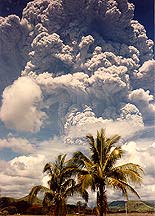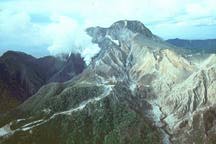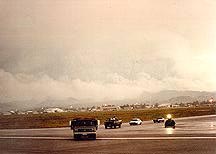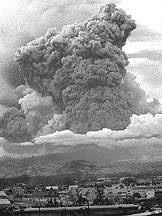
Page 2

| 2 Philippine Flyer
The Mount Pinatubo log |
 By mid-May, based on their air samples and earthquake measurements, the volcanologists determined Mount Pinatubo was building toward an eruption. Although unable to predict how large or when the event would be, they felt that if the current trend continued it could happen within the next 12 months. Before May ended, the earthquakes began to be stronger, more frequent, and closer to the surface. In early June, it became obvious that a large-scale eruption was imminent. Still, because volcanoes are by nature unpredictable and erratic, no one could say when. |

Then, June 10 at 5 a.m., because of continuing and increasing volcanic activity, Maj. Gen. William A. Studer, 13th Air Force commander, ordered the evacuation of all non-mission essential people and families to Subic. By 6 a.m., the first vehicles were rolling out the gate and little more than six hours later, about 14,000 folks were on the road. By nightfall, everyone was safe at Subic. At that point, the Navy had the tough job of finding quarters for everybody. It took awhile, and there were some uncomfortable moments, but by Tuesday night everyone had a roof over their heads. Once settled, all of us -- the evacuees at Subic, San Miguel and Cubi Point as well as the 1,500 mission essential people still at Clark -- began the waiting game. The mountain didn't keep us waiting long. When it exploded Wednesday, June 12, at 8:51 a.m., the base siren warned the mission essential team to bug out to the tent city at the far end of the runway. From there. we watched as the huge dark gray column of ash -- climbing at a rate of more than 1,000 mph -- shot up more than 60,000 feet. A spectacular and unforgettable sight, the plume mushroomed and billowed overhead until it filled the sky as far as we could see. |
 Surprisingly, though, no ash fell on Clark. The winds carried it off to the west -- dusting Subic and San Miguel -- and within two hours the skies over Clark were clear. By 4 p.m., all mission essential ash warriors were back on base. The eruptions continued from then on -- often peaking above 85,000 feet -- as mission essential team members adjusted to volcano living and sleeping conditions, bugging out to tent city became a frequent activity. The Mactan and Hill housing areas were on limits for sleeping, and cops had to be mobile. Everywhere people were sleeping someone had to be awake and in radio contact with the command post. Everyone parked their vehicles nose out and ready to go at all times. |

Wednesday night, Thursday morning, and then eight more times from Friday morning to Saturday morning, the siren blew to warn of impending eruptions or eruptions in progress -- and we headed for the flight line. Each time we waited for the all clear and then recovered back to main base...and each time the wait for the next warning blast grew shorter. The mountain definitely had us on the run. The end began on Saturday morning at 5:55, when the mountain erupted again -- this time with a different look from the previous explosions. Instead of plumes of gray ash steadily climbing ever higher, the darker- than-usual cloud immediately began spreading laterally. Wide-eyed ash warriors looking at the volcano that morning saw a wall of ash about five miles across rising into the leading edges of Typhoon Yunya, which just happened to be closing in on Clark with swirling winds and nearly 7 inches of rain. |
 At about 7:30 a. m., after yet another eruption, most of them headed for the college, too. Just a handful of folks were still at Clark in the early afternoon, when the day turned into night as falling ash and pumice stones blocked out the sun. But you didn't have to be at Clark to experience the daylight darkness. Evacuees at the college, Subic, San Miguel and Cubi Point all wondered the same scared thoughts when they looked outside at the total blackness. Because of the violent eruptions and earthquakes, lack of visibility (to be able to see whether or not pyroclastic flows were headed for Clark), loss of sensor data, and heavy ash and pumice swirling around us, General Studer gave the order for all remaining mission essential people to head for the college at about 2:30 p.m. The mountain had driven the Americans out of Clark. |
|
|
|
|
|
|
|
|
|
|
|